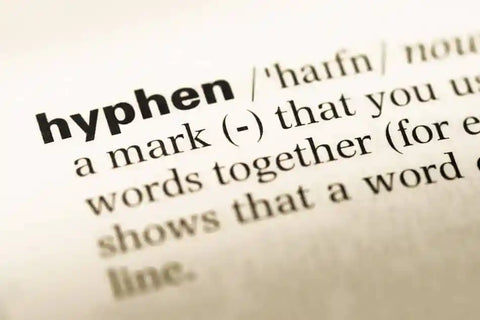Navigating the Challenges of Effective Hyphenation
There is no set of straightforward rules to govern the use of hyphens in the English language, which means that a consistent system of hyphenation can be incredibly tricky to establish in a scholarly article. The difficulty is largely due to the fact that using a hyphen or not often depends upon the context of a word or phrase – namely, its specific role and its position in a sentence. Some disciplines have conventional patterns of usage, so the journal to which you plan to submit your academic or scientific writing may provide guidelines that indicate how and when hyphens should be used. Such details are extremely rare, however, and it is more common for author instructions simply to recommend that hyphenation be kept to a minimum. This is sound advice: although some hyphenated terms are traditional, hyphens are often used with considerable subjectivity to clarify an author’s meaning, and excessive hyphenation can defeat this purpose as well as cluttering a text and rendering it less legible.
Correct hyphenation patterns in English often vary from term to term, and, like many other aspects of the language, they are rather fluid, so they can change. There is a tendency, for example, for hyphenated compounds to become closed with frequent use over time: the change from ‘on line’ to ‘on-line’ to ‘online’ is a good example. As a general rule, however, hyphens are used more extensively in British than in American English, so a good dictionary that provides some advice on hyphenation in one or both forms of the language is essential for looking up individual words and compounds. Beyond focussing on accepted patterns and clarity of meaning when using hyphens, you should ensure that each hyphenated element remains consistent throughout your article and that similar words and phrases used in similar ways feature similar hyphenation, at least as much as this is possible and sensible. Do keep in mind, however, that some compound terms will need to be hyphenated while other similar ones may not.
Soft or floating hyphens present different challenges. Whereas the hard hyphens discussed above are permanently placed to join words or parts of words (or other elements such as numbers) in the formation of compounds, soft hyphens are used to divide words at line endings in a text to create a more balanced or attractive layout on the page. Soft hyphens are not necessary in scholarly writing and since they are generally added to a document through automatic hyphenation functions such as that in Microsoft Word, which tend to introduce inappropriate word divisions, they are best avoided. If you do wish or need to use automatic hyphenation, be sure to scan the line endings in your text for misleading divisions: ‘exact-ing’ and ‘re-appear’ are acceptable divisions for ‘exacting’ and ‘reappear,’ for instance, but ‘ex-acting’ and ‘reap-pear’ are not.
Whether automatic hyphenation is used or not, however, words appearing in the columns of tables will sometimes become divided in nonsensical and distracting ways if the columns are too narrow to accommodate them. The word ‘percentage,’ for instance, might be incorrectly divided over three lines to read ‘perc-enta-ge.’ In tables designed to report data in striking and immediately comprehensible visual forms, such errors are unattractive and unprofessional, so do watch for them if you are including tables in your article. If necessary, use abbreviations, make the columns in the tables concerned a little wider to allow the words enough space or restructure the tables with plenty of room for the headings to appear in a legible fashion.
Why Our Editing and Proofreading Services?
At Proof-Reading-Service.com we offer the highest quality journal article editing, dissertation proofreading and online proofreading services via our large and extremely dedicated team of academic and scientific professionals. All of our proofreaders are native speakers of English who have earned their own postgraduate degrees, and their areas of specialisation cover such a wide range of disciplines that we are able to help our international clientele with research editing to improve and perfect all kinds of academic manuscripts for successful publication. Many of the carefully trained members of our manuscript editing and proofreading team work predominantly on articles intended for publication in scholarly journals, applying painstaking journal editing standards to ensure that the references and formatting used in each paper are in conformity with the journal’s instructions for authors and to correct any grammar, spelling, punctuation or simple typing errors. In this way, we enable our clients to report their research in the clear and accurate ways required to impress acquisitions proofreaders and achieve publication.
Our scientific proofreading services for the authors of a wide variety of scientific journal papers are especially popular, but we also offer manuscript proofreading services and have the experience and expertise to proofread and edit manuscripts in all scholarly disciplines, as well as beyond them. We have team members who specialise in medical proofreading services, and some of our experts dedicate their time exclusively to dissertation proofreading and manuscript proofreading, offering academics the opportunity to improve their use of formatting and language through the most exacting PhD thesis editing and journal article proofreading practices. Whether you are preparing a conference paper for presentation, polishing a progress report to share with colleagues, or facing the daunting task of editing and perfecting any kind of scholarly document for publication, a qualified member of our professional team can provide invaluable assistance and give you greater confidence in your written work.
If you are in the process of preparing an article for an academic or scientific journal, or planning one for the near future, you may well be interested in a new book, Guide to Journal Publication, which is available on our Tips and Advice on Publishing Research in Journals website.








